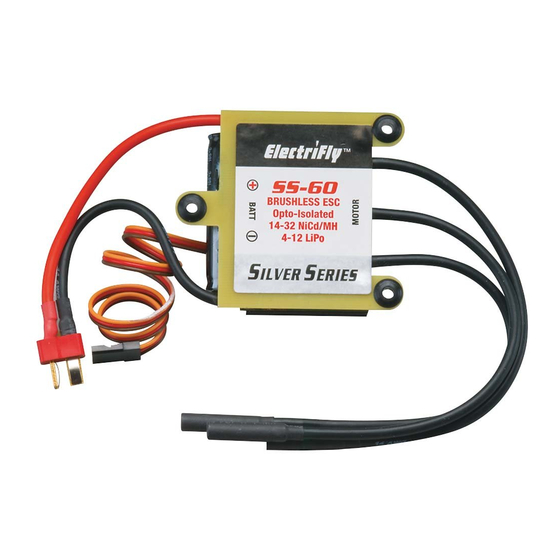GREAT PLANES ElectriFly Silver Series SS-60 Руководство - Страница 3
Просмотреть онлайн или скачать pdf Руководство для Контроллер GREAT PLANES ElectriFly Silver Series SS-60. GREAT PLANES ElectriFly Silver Series SS-60 4 страницы. High voltage brushless electronic speed controls

1. Move the throttle stick to full throttle, turn on the transmitter
and connect the battery to the ESC.
2. After 5 seconds the motor will beep twice.
3. Move the throttle stick to the off position (towards you).
The motor will beep twice.
4. Again move the throttle stick to full power. The motor will
beep twice to confi rm the brake is now "on".
5. Move the throttle stick back to off. The motor will now beep
four times indicating the motor is "armed".
Once set, the brake function will be stored in the ESC until
changed again manually.
To turn the brake off, repeat the above process. This time
the motor will only beep once with each stick movement, but
will beep four times again at the end to indicate the ESC is
armed.
ESC OPERATION
1. Turn the transmitter's power on.
2. Move the throttle stick to the off or brake position (towards
you).
3. Turn on the Rx switch harness, and then connect the
battery to the ESC. The motor will beep to indicate the
brake setting (once for off, twice for on).
4. Move the throttle stick to full. The motor will again beep
once or twice to indicate the brake setting.
5. Move the throttle stick to off or brake and the motor will
beep four times. The ESC is now "armed".
WARNING!! Advancing the throttle stick will
now cause the motor to rotate! Stay clear of the
motor's shaft!
If the ESC does not operate properly or makes a low-pitched
beeping sound following the above setup procedure, disconnect
the battery from the ESC, reverse the throttle setting on the
transmitter and repeat the ESC setup.
SAFE-START: As a safety precaution to prevent the motor from
rotating when the battery is fi rst connected, you must "arm"
S
SPECIFICATIONS
Input voltage:
BEC:
Output current:
Max. output power:
Brake:
Rotation direction:
Timing angle:
Operating frequency:
Low voltage cutoff:
On resistance:
Thermal cutoff:
Dimensions:
Weight:
14-32 NiCd/MH cells, 4-12 LiPo cells (12.4-50V)
no BEC circuit, opto-isolated
60A continuous, 72A surge
Starting battery voltage x 0.74
2.3 x 1.9 x 0.7 in. (58 x 48 x 18 mm)
3.13 oz. (89 g, w/Star Plug,
Rx plug, three 4mm bullets)
* can be adjusted with optional programming card (GPMM1895)
the ESC every time you connect the battery. The propeller will
NOT rotate until the ESC is armed. To arm the ESC, move the
throttle stick to full position, then back to off (or brake). Now
the motor will rotate anytime the throttle stick is advanced
away from the off position! Care must be exercised when
near the model's propeller!
WARNING!! If the ESC and motor have already
been armed and the motor has been rotating normally,
yet after moving the throttle stick to near minimum
the motor suddenly ceases to rotate normally even if
the throttle stick is advanced above minimum throttle, DO NOT
PLACE YOUR HANDS NEAR THE PROPELLER!! From this
point moving the throttle stick up - even to full throttle - might not
cause the motor to rotate BUT THE MOTOR IS STILL ARMED
AND ACTIVE DURING THIS TIME!!
To regain control of the motor, move the throttle stick to absolute
minimum throttle position and then advance the throttle stick
upwards once again. Alternatively, you can disconnect the
battery from the ESC, and then re-connect the power source
and re-arm the system. This condition might occur if the ESC
determines that a problem exists with the motor and/or speed
control, or if something obstructs normal rotation of the motor.
The ESC will completely stop the rotation of the motor to
protect the speed control from possible damage. NEVER get
near the propeller if the speed control is connected to input
power! ALWAYS make sure the throttle stick is at minimum
position before attempting to disconnect the battery from the
speed control!
7
RANGE TEST
Because electric motors generate electrical noise, it's critical
to range test the airplane before fl ight with the motor on. With
the Tx antenna collapsed and a helper holding the airplane,
operate the fl ight controls while walking away from the airplane.
You should be able to get approximately 75 to 100 feet [22-30m]
away before losing control of the airplane's surfaces. Next,
check the range with the motor running at half throttle. The
range should be close to the range you got with the motor off. If
it is not, you may need to move the receiver, receiver antenna,
servo leads or the speed control to a different location.
SS-60
14-32 NiCd/MH cells, 4-12 LiPo cells (12.4-50V)
3000 watts
ON or OFF
Forward only*
12 degrees*
8 kHz*
0.004 ohms
230° F (110°C)
3
SS-80
no BEC circuit, opto-isolated
80A continuous max., 96A surge max.
Forward only*
12 degrees*
Starting battery voltage x 0.74
230°F (110° C)
2.4 x 2.6 x 0.7 in. (60 x 67 x 18 mm)
5.1oz. (145 g, w/Star Plug,
Rx plug, three 6 mm bullets)
4000 watts
ON or OFF
8 kHz*
0.002 ohms
